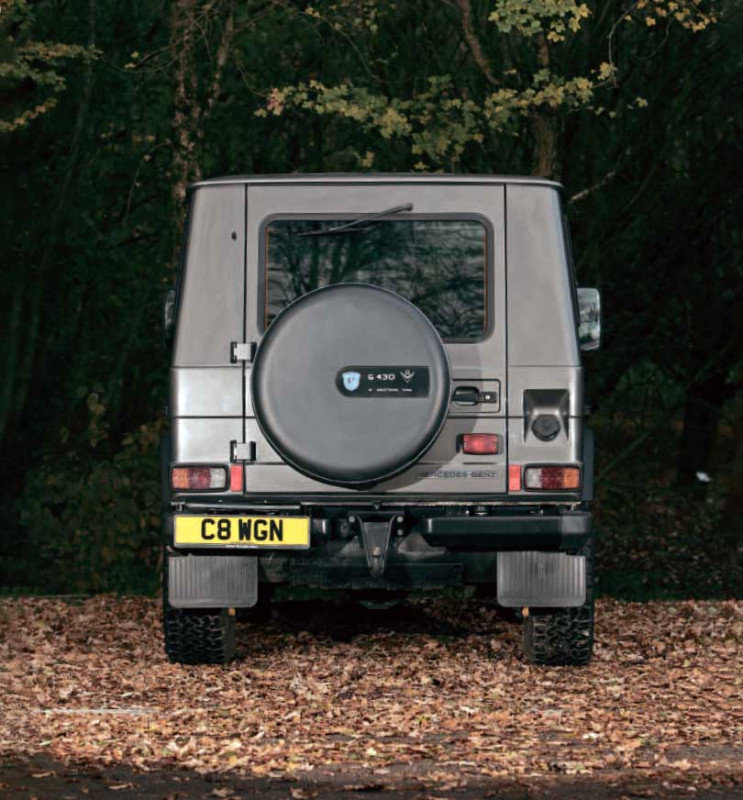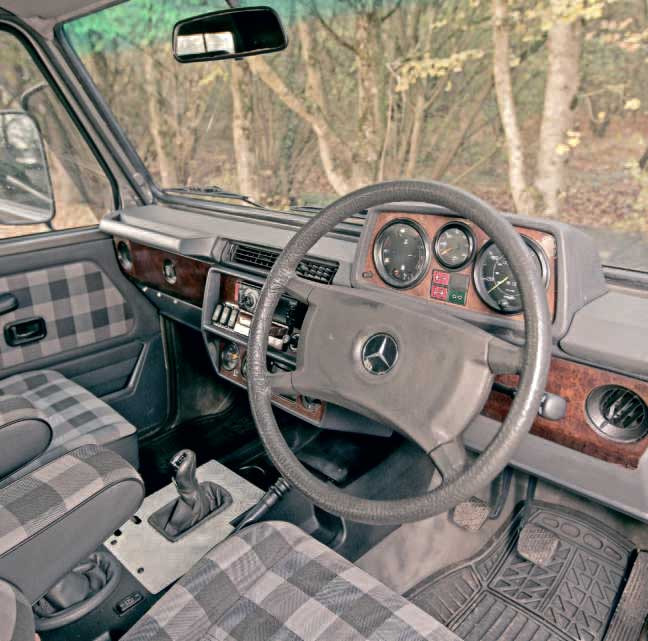Restored: Mercedes-Benz G-Wagen

Looking at these pictures you could be forgiven for thinking that this G-Wagen is something of a stealth machine, with its gunmetal paint, sharp edges and slab-sided panels. But the briefest of encounters with this unfeasibly cool 4x4 would soon make it clear that if there’s one thing that it cannot do, it’s stealth, on account of its ear-splitting soundtrack. If only there was some way for us to bring you moving pictures complete with sound. Maybe one day…
Sounding more like a Mercedes-McLaren SLR than a boxy offroader, the reason for the supercar-like noise that emanates from this 430GE is the V8 engine that sits in the nose. If you’re a G-Wagen afficionado you will know that no Mercedes-Benz W460 ever left the factory with V8 power, which is why there’s quite a story behind this one. Mike Axel-Berg is the man who made it happen.

Mike comments: “In right-hand drive form, the original G-Wagen, the G460, was never offered with any engines that made driving a pleasure. They were all gutless; detuned to run on poor-quality fuel. In 2002, I bought a 280GE with a 2.8-litre petrol engine. On a good day I might have had 100bhp at the wheels and 150bhp at the crankshaft, which made driving it very hard work indeed, so I decided to build something much more usable. It was something that several other people had tried before, but it’s such a difficult thing to do that nobody had ever been successful.
“My business partner had an E-Class with the OM606 diesel engine, and I could see that it was just what the G-Wagen was crying out for. So I bought a written-off E-Class and then worked out how to get rid of the electronics to transplant the straight-six into the G-Wagen’s engine bay. My approach was to remove all of the engine’s ancillaries, install the engine, then work out how to fit each of the ancillaries with suitable modifications. It took a while, but by 2011 my 3.0-litre turbodiesel G-Wagen was up and running, with its OM606 engine and six-speed manual gearbox. The car had twice as much power and torque than before, but it burned half as much fuel. Even better, my G300 was fabulous to drive; it felt just like it should have done when it had left the factory.”

Mike promoted his conversion within G-Wagen circles and quite a few people refused to believe that he had pulled off the supposedly impossible. So he ran an open day at his workshop so that fellow enthusiasts could take a closer look and enjoy a ride in this miracle machine. The car was so well received that Mike quickly gained a reputation for being the go-to person for solving tricky installation conundrums.
It didn’t take long for Tony, a Jersey-based G-Wagen owner, to contact Mike, asking for the same conversion, which was duly completed. Delighted with his new toy, Tony then asked Mike if he could undertake another engine conversion, but this time with a 5.0-litre V8 petrol engine. Mike turned him down because it would have meant engineering a conversion from scratch, so Tony had to console himself with having just one fast G-Wagen to play with. However, eight years later he contacted Mike once more, to ask the same thing: would Mike build him a V8-powered W460?
While Mercedes didn’t build any V8-powered W460s, it did build 11 right-hand drive W463s with a 5.0-litre V8, with the updated G featuring basically the same bodywork and chassis as the earlier model. By chance, at that time Mike was approached by the owner of one of these ultra-rare 4x4s, with a request for a complete restoration to be carried out. Mike negotiated for Tony to buy the car instead, and Mike then revived it to live a life of leisure on Jersey.

Mike continues: “The car was delivered from its Scottish home, and I immediately wondered what I’d got myself into. The rust was catastrophic, but I was committed to rebuilding it, so I separated the bodyshell from the chassis and set about grafting in huge repair sections taken from a donor chassis, as new chassis weren’t available. To cut a very long story short, that car consumed vast amounts of time but it was fully restored before being shipped over to Jersey for Tony to enjoy, although what he really wanted was a V8-powered W460, rather than a 463…”
Before the G-Wagen was sent to its new home in the Channel Islands, Clive, a long-standing friend of Mike’s, sampled it and was rather taken by it. In 2016 he had bought the G-Wagen pictured here, which had previously been fitted with a 2.9-litre Mercedes Sprinter turbodiesel engine. It went pretty well, but what Clive really wanted was a V8 petrol engine, having sampled Tony’s new toy. He persuaded Mike to build one for him, using his late (1989) W460 as a basis.
Mike adds: “It didn’t take long to remove the Sprinter engine, which was promptly sold, complete with the gearbox. This was it; I was now completely committed to finishing Clive’s car and it would have to be with V8 power. We scoured the small ads and various classified websites along with eBay, and it was the latter that came up with the goods. In Yorkshire there was a guy who was selling a 1999 Mercedes-Benz ML430 W163 with just 66,000 miles on the clock. The mechanicals were in superb condition, but the bodyshell was absolutely hanging – beyond repair.”

The ML had been used all-year round in wintry weather, and the bodywork had dissolved as a result. The vendor had inherited the car from the first owner, Lord Gregson of Stockport, a man who rallied a Cortina Lotus Mk2 and whose road car was a Broad-speed Capri, so he was something of a petrolhead, which is why the car was in superb condition mechanically. But it was as rotten as a pear. Because the ML’s gearbox was an automatic and Clive specifically wanted to swap cogs himself, a suitable manual transmission had to be sourced. But which one? Mike says: “The automatic gearbox is electronically controlled which brings in all sorts of potential problems with compatibility; plus a slushbox damps out much of the feel, so I took a chance on a suitable manual gearbox (it’s a trade secret so we can’t tell you which car donated it…), and it went in perfectly.
“When I’d restored the factory-built right-hand drive G500, I took lots of measurements of where everything was mounted, and it was thanks to this experience that I was able to buy all of the correct mounts which I could then fit in the right place. Lots of other people have tried to build V8-powered 460s and they’ve all become croppers because there are so many clearance issues all over the front of the car. My experience with the G500 made things a lot easier and quicker to do, although it was still a massively involved project.”
Fitting the V8 meant moving the radiator and its mounts as well as completely changing the cooling and fuel systems, including the wiring and all of the pipework for the fuel feed, while the fuel pressure regulator had to be rejigged. There was no room for the exhaust manifolds, the steering box didn’t clear the bottom of the engine, and the steering column didn’t clear the manifolds once they had been rejigged to fit. It’s no wonder everybody who had tried to undertake such a project before, had given up. Things were made easier by the possibility of ordering RHD V8 W463 parts, but some of these had to be modified to put the jigsaw puzzle together. The conversion would consume over 1000 hours all in, although this did also include a fair amount of restoration work too.
As well as working out how to fit an engine into a space that it really wasn’t designed for, Mike also had to put right a stack of previous bodywork bodges which involved repair sections being poorly grafted in. The rear suspension and front body mounts were replaced, the chassis was repainted, poly bushes were fitted to the suspension throughout, along with fresh springs and Bilstein dampers. This was another area that caused much head scratching. Mike comments: “The all-alloy V8 engine was much lighter than the cast-iron diesel unit that came out, so I had to work out which springs would provide the correct ride height front and rear, while also providing a decent ride and handling balance. When Clive brought the car to me it drove pretty badly, wandering all over the road thanks to its vague steering and tired suspension, so it wasn’t hard for me to improve things. But it was time consuming, as I tried half a dozen different spring combinations to come up with one that worked. In the end I settled on a combination of G500 short-wheelbase springs at the rear, with long-wheelbase G55 items up front. The result is a car that’s quite brilliant to drive.”
One of the biggest tasks with the project was getting the engine to run correctly, once it had been shoehorned into a space that was frankly quite a bit too small. In the ML an array of ECUs, sensors and other gadgetry had kept the engine running sweetly, and much of this had to be transferred to the G-Wagen. Mike’s initial route was to modify the ECU, but there didn’t seem to be any way of getting round the immobiliser, so while the engine would run, it wouldn’t do so happily.
Mike says: “After a false start with a company that wasn’t very helpful, I found one that was really keen to make the project work. The M113 V8 that we’d fitted, has two spark plugs per cylinder. The first company would fire only one plug per cylinder which wasn’t much use, and in standard form the ignition system fires the plugs sequentially. I wanted them to fire simultaneously and the company that I found could do that. Even better, they could modify the ECU for the engine to run without the rest of the ML’s electronics.
“I fitted the ECU between the front bulkhead and the dashboard, so it was protected from heat and water, and that meant cutting away part of the glovebox. As with everything that I did to the car, the aim was to make everything look as though it had been fitted by the factory. I sourced an ITG intake system that sits between the engine and the offside inner wing, which gulps in air via the snorkel which runs up the driver’s A-pillar. The header tank for the new cooling system is a beautifully welded alloy cylinder which mounts on the nearside inner wing, and I even had a set of bespoke badges cast for the front doors, with ‘430GE’ on them, as the factory never made such a car.”
The next step was to have an exhaust system made up, which Mike did through a company that he’s used on numerous occasions. Using a G55 system as a start point, Mike’s approach was to have two four-cylinder set-ups made, each exiting from behind the side doors; there’s no balance pipe as there’s no room for one.
With the exhaust plumbed in, the next step was to get everything set up on a rolling road. The mixtures were set for each bank, along with the idle speed, and with the ignition advanced to maximise the available power, the result was a peak output of 250bhp and 322lb ft of torque at the back wheels. That translates to around 285bhp at the flywheel, which is about 20bhp up on the factory V8, putting it more or less on a par with the standard 5.0-litre V8. With no electronic aids at all, such as ABS or traction control, that’s more than enough to keep amuse Clive. Driven gently, the V8 will even return 16mpg on a run, although it’s not hard to guzzle super-unleaded at twice this rate. Despite the extra power and torque, a disc/drum brake combination is still installed, albeit from a 1980s Mercedes 307D van. With a new master cylinder, braided hoses and all-new parts front and rear, the set-up is more than adequate because Clive’s unlikely to take his G-Wagen on any track days. Although you never know…
Mike concludes: “Since the 430GE was finished I haven’t had to do any fettling, undertake any revisions, and nothing has gone wrong. Clive has been using it with no teething problems at all, but this winter I’ll be installing a W463 air conditioning system ready for next summer. The parts were donated by the ML and they’ll hopefully go straight in. Mercedes did offer air-con on the W460, but not as a factory-fit option. Bizarrely, it was a dealer-fit item and it used an aftermarket system that was rather crude. I’m going to follow what Mercedes fitted to the W463 so that should be pretty straightforward as such conversions have been done before. With that work undertaken, Clive’s G-Wagen should be the coolest 4x4 on the block in more ways than one.”
How it was done
- 1. The rotten donor ML430 V8 W163 is delivered to Mike’s workshop for its engine to be removed before the rest is scrapped.
- 2. Separating the bodyshell from the chassis represented a major turning point in the restoration of the G-Wagen.
- 3. With the running gear removed the chassis can have a thorough steam clean so the workload can be assessed
- 4. With the chassis fully restored and modified to take the V8 engine it gets painted in twopack slate black.
- 5. Electrical spaghetti. It took almost two weeks to trace back all of the wires on the engine’s wiring loom.
Know your G-Wagens
Originally developed as a military vehicle, the G-Wagen went into production as a civilian car in 1979; UK sales started two years later. There was a choice of four-cylinder 230G and six-cylinder 280GE petrol engines, along with four-pot 240GD and five-pot 300GD diesel options. Buyers could also choose between short-wheelbase threedoor and long-wheelbase five-door models. Those first cars all came with a manual gearbox, but by 1981 there was an automatic option.
Things ticked over until 1990 when the G-Wagen was given a major overhaul, which brought an all-new interior and permanent four-wheel drive. A trio of diff locks became standard and anti-lock brakes were added to the options list. The changes were significant enough for this car to get its own Mercedes model designation; the previous G-Wagen was known as the W460, but the new one was codenamed W463. There was also a W461 (military-spec) and W462 (G-Wagens made from kits and assembled in overseas factories).
This new incarnation of the G-Wagen (which was rebranded as the G-Class in 1993) was intended to be more upmarket, to appeal to those wanting a road-biased passenger car rather than a hard-core off-roader. An array of six- and eight-cylinder petrol and diesel engines was introduced, and from 2012 there was even an insanely expensive twin-turbo V12- powered G65 AMG edition. But the G’s limited on-road abilities and high price guaranteed low sales; the G-Wagen was originally sold in the UK between 1981 and 1996, in which time 5000 were sold. Sales resumed in 2010, but only at a trickle thanks to fantastically high prices.

